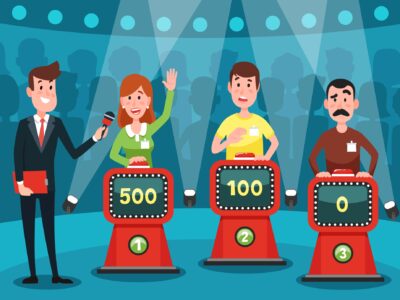Gamification in the workplace can be an incredibly effective way to increase employee engagement. Introducing game concepts, such as point scoring and competition, brings in an element of fun that helps keep employees motivated and productive. Statistics back this up as well. According to a Mambo report, effective gamification in the workplace can increase employee engagement by 48%. That same report also found that 95% of employees prefer a gamified work environment.
On a basic level, gamification is just the utilization of game elements in the workplace. This includes things like leaderboards, prizes/rewards, and more to encourage friendly competition that motivates and engages employees. Today, we’re going to take a deeper look at game-based learning and how it can be used in the workplace to increase employee engagement. We’ll look at the basics of gamification, its benefits, how to implement it, and ideas you can use to incorporate it in your workplace.
Understanding Gamification in the Workplace
To begin, let’s start with what gamification at work actually is. Gamification at work can be defined as the incorporation of game elements into non-game scenarios, such as work or studying.
What makes gamification so important in the workplace is the impact it can have on employees and their engagement. Game elements like a prize for the person who makes the most sales can drive them to be more motivated, increasing their engagement. It’s really about creating an environment that encourages engagement and pushes people to be more involved in the workplace. This is something Stephen Baer, Co-Founder and Chief Creative Officer of The Game Agency, noted in one of our podcasts, saying:
“Companies need to think about providing an ecosystem where they can drive that motivation. Whether it’s intrinsic or extrinsic motivation, really pushing that employee to participate in the greater cause.”
By utilizing these techniques, businesses can create a workplace where employees are more motivated to complete tasks and do their best. And in turn, this creates better outcomes for the business as a whole. For example, say you have a marketing team and are working on a big campaign. Offering a reward of an extra vacation day to whoever comes up with the winning proposal can make a huge difference.
That extra vacation day can be a huge motivation for employees. They want that extra vacation day, and they’ll work harder than usual to ensure they have a shot at winning. And in doing so, employees also become more engaged. It’s relatively simple at the end of the day, yet it can have a big impact on your employees and their performance. Statistics back this up as well.
A Zippia report found that 90% of employees say their productivity increases when the workplace is gamified and that gamified workplaces are seven times more profitable than non-gamified workplaces. If you’re wondering how to engage employees, gamification in the workplace is one of the best options available. So let’s keep going and focus on the benefits of employee gamification.
Benefits of Employee Gamification
There are many benefits to employee gamification in the workplace, and it’s important to fully understand the benefits if you want to implement gamification as effectively as possible. The biggest benefit arguably is that it increases employee engagement. Engagement is all about the connection between employees, their job, and their workplace. Gamification makes employees connect on a deeper level with their work through driving participation. By utilizing game elements–like inventive games to motivate employees—workers are pushed to be more engaged. They want to win and do better, which ultimately results in higher engagement.
As for engagement, it has numerous benefits of its own. Engaged employees are generally more satisfied and productive, which increases business outcomes. Game-based learning also helps keep employee engagement fun. While many think employee engagement is boring or dry, gamification allows for boosted engagement through fun means. It also facilitates learning and professional development in an enjoyable way. Professional development via gamification, such as in the form of professional development workshops, can help employees improve their skills while simultaneously boosting engagement and satisfaction.
Another big benefit is the effect it has on collaboration and team dynamics. It can strengthen and improve both of these, resulting in better outcomes for both employees and their employers. Employees want to do their best to win, and that promotes collaboration. In turn, that can boost team dynamics, resulting in stronger and more cohesive teams.
It can also boost morale. Games are fun, and employees are going to feel more satisfied when they are having fun at work. And in doing so, employees are much less likely to leave when they feel engaged and satisfied at work, lowering turnover rates.
How to Implement Gamification Into the Workplace
With the benefits covered, let’s look at some actionable strategies to help businesses gamify the workplace.
Setting Clear Objectives
A key aspect of successful team gamification is setting clear objectives. Having clear objectives for employees helps them see the finish line and strive to achieve these goals as effectively as possible. Consider using the SMART goals format. This can help ensure that your goals are specific, measurable, achievable, achievable, relevant, and time-bound, resulting in goals that help instead of hinder.
Utilizing Engaging Games
You can’t have gamification in the workplace without games, and the choice of games is incredibly important. You want to ensure that your games, whether you design them yourself or partner with a company like TeamBonding, are truly engaging. Make sure that the games you choose are relevant to employees and your goals. Every workplace is different, so get to know your employees and pick games that align with their preferences and your business objectives.
Real-Time Rewards and Feedback
Real-time rewards and feedback are also key to engaging your employees. Rewards keep them driven towards the goal, and feedback helps them see their progress and look for ways to improve. This can be as simple as rewards for achieving certain milestones or having a leaderboard that tracks progress toward a goal. For example, you might have a whiteboard in the office where employee progress toward the goal is tracked, providing real-time feedback.
Healthy Competition
Healthy competition can be an incredibly effective way to boost engagement and productivity. Competition drives people to do better, working their hardest to come out on top. An event like Amazing Race Around the World can be a great way to spur healthy competition. However, make sure that competition stays healthy and doesn’t veer towards toxicity.
Gamification Ideas for Employee Engagement
Now, let’s shift to talk about some ideas for gamification in the workplace. Your efforts are only as effective as the games and concepts you implement. Stephen Baer highlighted this in our podcast when he said:
“The whole point is to make the content really compelling, make sure that they can dive into it, engage with it, participate with it, see what we learn from it. Right? And also make it a safe place to fail.”
So here are some gamification ideas for employees you can implement, broken up by each type.
Professional Development Gamification
As discussed earlier, gamification can be used to further professional development while having fun and boosting engagement. This type of gamification includes the benefits associated with both professional development and game-based learning, making it a valuable tool.
Many team building events focus on professional development gamification, like StrengthsFinder Training. This event helps employees identify their strengths and the strengths of those around them in a fun, gamified manner. And if that event doesn’t seem like a good fit for your team, numerous other employee training programs include gamification for employee engagement.
Performance Management and Goal-Tracking Initiatives
Performance management and goal-tracking initiatives are another type of gamification in the workplace, and they can be incredibly effective when it comes to increasing engagement, productivity, and business outcomes.
Leaderboards and challenges are a popular option here. Leaderboards with associated challenges allow employees to track their progress, encouraging them to get competitive and strive to do their best. Alongside that, there are typically rewards associated with achieving those goals. Rewards, small or large, give employees incentives and encourage them to go all-out in their efforts.
Group Challenges and Team Building Gamification
For those looking to focus on the team element of gamification, group challenges and team building are a great choice. This type of gamification really hones in on bringing a team together through game elements, creating more cohesive and effective teams. Team building events serve well here. An event like The Big Picture encourages collaboration, creativity, and prioritizing the bigger picture while also building bonds and introducing a competitive element. There is a nearly endless amount of team building events and activities, so look around and find one or more that are a good fit for your team and organizational objectives.
Sales Incentive Games
The last type of gamification in the workplace is sales incentive games to motivate employees. These tend to be some of the most straightforward, offering rewards or prizes for achieving certain sales objectives.
For example, you might set a series of sales goals. Employees receive some sort of reward for achieving each of those goals, while the person who has the most sales at the end of the period receives another special reward. This might sound simple, but rewards are a surefire way to motivate employees, boost their engagement, and bring out the best in them.
Increase Employee Engagement with Team Building and Gamification
While gamification can seem like a frivolous thing that just makes work a bit more fun, it can have massive impacts on employees and a business as a whole. Gamification can lead to increased employee engagement, motivation, productivity, retention, and more. For businesses, that ultimately translates into better outcomes that help them achieve their goals.
Team building is a powerful tool in the realm of gamification and engagement. It can introduce games into the workplace, bring your team together, and further the benefits that come with gamification.
At TeamBonding, we have a thorough understanding of gamification, team building, and how to help businesses utilize them to reap the benefits. Through our decades of experience, we have built up a catalog of events that utilize gamification to increase employee engagement. Motivate your team with the power of gamification in the workplace and drive your business toward further success. Get in touch with us to learn more about how we can help you increase engagement through gamified team building.















